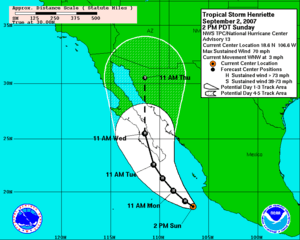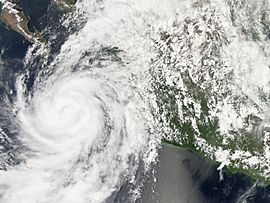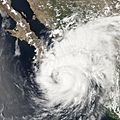Hurricane Henriette (2007) facts for kids
| Category 1 hurricane (SSHWS/NWS) | |

Henriette near the southern tip of the Baja California Peninsula
|
|
| Formed | August 30, 2007 |
|---|---|
| Dissipated | September 6, 2007 |
| Highest winds | 1-minute sustained: 85 mph (140 km/h) |
| Lowest pressure | 972 mbar (hPa); 28.7 inHg |
| Fatalities | 9 direct |
| Damage | $25 million (2007 USD) |
| Areas affected | Southwest United States, Southwestern and northwestern Mexico, including the Baja California Peninsula |
| Part of the 2007 Pacific hurricane season | |
Hurricane Henriette was a powerful tropical cyclone that hit Mexico in 2007. It was the deadliest storm of the 2007 Pacific hurricane season, causing nine deaths.
Henriette started as a cloudy area on August 30, 2007. It quickly grew into a tropical storm the next day. The storm moved along Mexico's Pacific coast, bringing very heavy rain.
The city of Acapulco, Guerrero, was hit hard. Six people died there because of landslides. Over 100 families had to leave their homes after the La Sabana River flooded.
Henriette then turned north towards the Baja California Peninsula. It became a Category 1 hurricane on the Saffir-Simpson Hurricane Scale. The storm made its first landfall near Cabo San Lucas when it was at its strongest. One woman died there due to the rough ocean waves.
After that, Hurricane Henriette moved over the Sea of Cortez. It made its second landfall near Guaymas, Sonora. The storm brought heavy rains to Sonora. It then weakened over the Sierra Madre Occidental mountains. What was left of the storm later caused flooding in New Mexico and Texas.
The damage from Henriette cost about $25 million in 2007 US dollars. It was unusual because it hit Mexico on the same day Hurricane Felix hit Nicaragua. This was one of only two times that an Atlantic hurricane and a Pacific hurricane made landfall on the same day.
Contents
How Hurricane Henriette Formed
Hurricane Henriette began as a tropical wave. This wave started off the coast of Africa on August 20, 2007. It moved across the Caribbean Sea and reached Central America by August 28.
On August 30, a low-pressure area formed about 400 miles (640 km) south-southeast of Acapulco, Mexico. This area started to show strong storm clouds. By the afternoon, it had a clear center of swirling air. Early on August 30, it officially became a tropical depression.
The storm kept getting stronger, but it faced strong winds from the east. These winds made it harder for Henriette to grow very powerful. The storm first moved west-northwest, following a high-pressure system. It then moved northwest, staying close to Mexico's west coast. On August 31, it became Tropical Storm Henriette.
Henriette continued along the Mexican coast, bringing lots of rain. Even though the water was warm, the storm didn't get as strong as expected. This was likely because it was so close to land. On September 1, Henriette turned west and moved away from the coast.
Henriette Becomes a Hurricane
Henriette's structure kept getting better. On September 4, it formed a clear eye, which means it became a hurricane. It turned north-northwest towards the Baja California Peninsula.
The hurricane reached its strongest point that morning. Its winds were about 85 mph (135 km/h). This was when it was about 75 miles (120 km) south-southeast of Cabo San Lucas.
Henriette's center made landfall just east of Cabo San Lucas on the afternoon of September 4. Its winds were about 80 mph (130 km/h). It was over land for only about six hours before moving into the Sea of Cortez. Being over land made it a little weaker, but Henriette stayed a Category 1 hurricane for most of that day.
The next day, it made its final landfall near Guaymas in Sonora. Henriette quickly weakened over land and disappeared over the mountains of northwestern Mexico on September 6. What was left of the storm moved across west Texas and southeastern New Mexico. It caused flash flooding and strong thunderstorms there.
Preparing for the Storm
Weather experts in Mexico didn't expect Henriette to form so quickly. They first mentioned the storm only about 31 hours before it became a tropical depression.
On August 31, 2007, Mexico's National Meteorological Service issued an alert. It covered the coast from Oaxaca to Jalisco. They told people to be ready for heavy rain, strong winds, and storm surges.
In Guerrero, schools were closed in the evening. The port in Acapulco stopped all small boats from sailing. Blue and yellow flags were put up to warn swimmers.
On September 4, the port of Mazatlán, Sinaloa, also had to close. This was because of the hurricane's bad weather. Waves were over 13 feet (4 meters) high. A cruise ship, the Carnival Pride, had to change its route. Schools in Mazatlán were closed for two days. Officials said about 600 families might need to leave their homes. Further north, the port of Topolobampo, Sinaloa, also closed. About 20 families were moved from their homes there.
In La Paz, officials opened 13 temporary shelters. They expected to move over 2,000 people from dangerous areas. Local police told people in risky areas to stay home unless necessary. They also advised finding safe evacuation routes. Both the Manuel Márquez de León International Airport and Los Cabos International Airport were shut down. This left 7,500 to 8,500 tourists stuck. The ports in Los Cabos closed completely, and the port in La Paz closed for small boats.
What Happened After the Storm
Henriette hit the resort town of Acapulco very hard. Even though the storm didn't pass closer than 70 miles (110 km) to the town, heavy rains caused the ground to become very wet. This led to dangerous mudslides.
Six people died in Acapulco from rockslides in two neighborhoods. Three people were killed when a huge rock hit their house. The other three died when their homes partly collapsed. Also, the River La Sabana overflowed, causing floods. At least 100 families living near the river had to be moved to safety.
The Director of Civil Protection for Acapulco reported that about 800 people were hurt. Also, 337 people went to temporary shelters. In Michoacán, Henriette damaged a large area of beach near Ixtapilla. It destroyed about 5,000 Olive Ridley turtle nests. This was 10% of the nests for this endangered species in the state.
In Sonora, the hurricane destroyed 450 homes. It also damaged another 5,000 homes in Etchojoa and Huatabampo. These areas have many Mayo Indian communities. The storm's rain flooded nearby farms, stopping wheat production. Local government had to spray for mosquitoes to prevent a dengue fever outbreak. In the Yaqui River valley, two people died. Another 70 homes were destroyed by Henriette's winds. In total, 24,000 families in Sonora lost their homes.
One woman died due to high waves near Cabo San Lucas on the Baja California Peninsula. Two fishermen were reported killed off the Sonora coast.
The road connecting Guaymas to Ciudad Obregón was closed. This was because of damage from the overflowing Cocoraque brook. About 600 cars were stuck. Lázaro Cárdenas was affected when the Acalpican River flooded. At least 50 houses in the community of El Habillal were flooded with water up to 3 feet (1 meter) deep. Residents had to leave their homes and go to temporary housing.
The leftover parts of Henriette caused flash floods in the U.S. States of New Mexico and Texas. Roads were covered with water 8–12 inches (20–30 cm) deep. Hail also piled up on the roads.
The total damage in Mexico was about $25 million in 2007 US dollars. The name Henriette was not removed from the list of hurricane names. It will be used again for future storms.
Related pages
- List of Pacific hurricanes
- 2007 Pacific hurricane season
- List of Baja California hurricanes
- Timeline of the 2007 Pacific hurricane season
Images for kids
See also
 In Spanish: Huracán Henriette (2007) para niños
In Spanish: Huracán Henriette (2007) para niños





